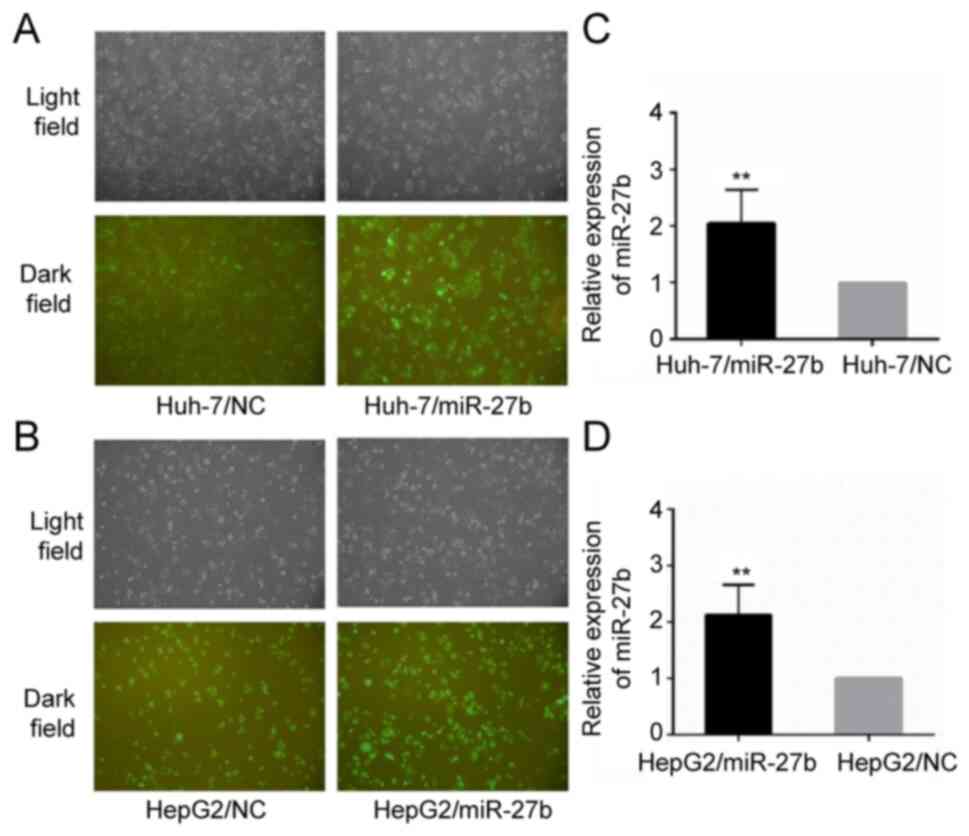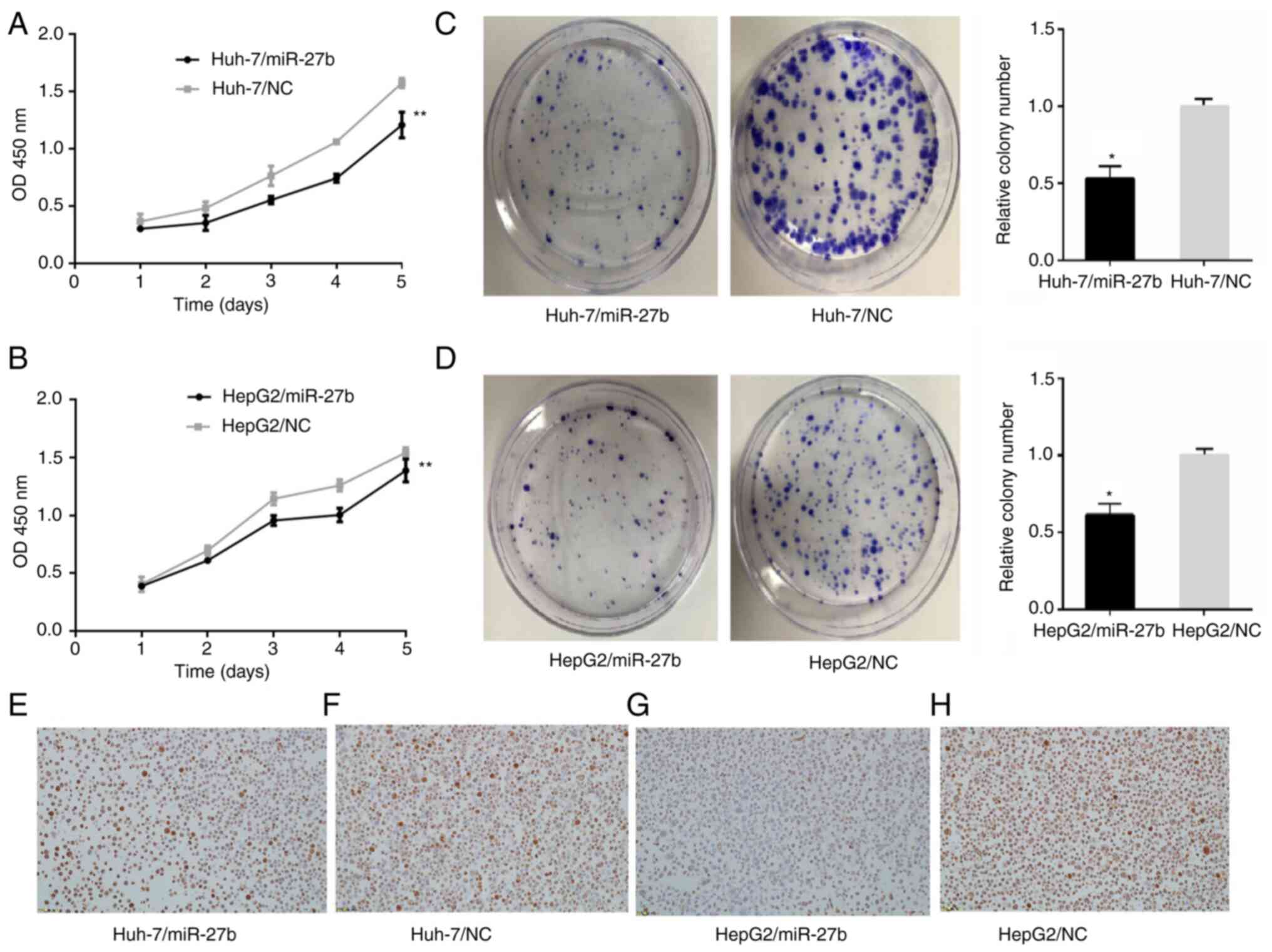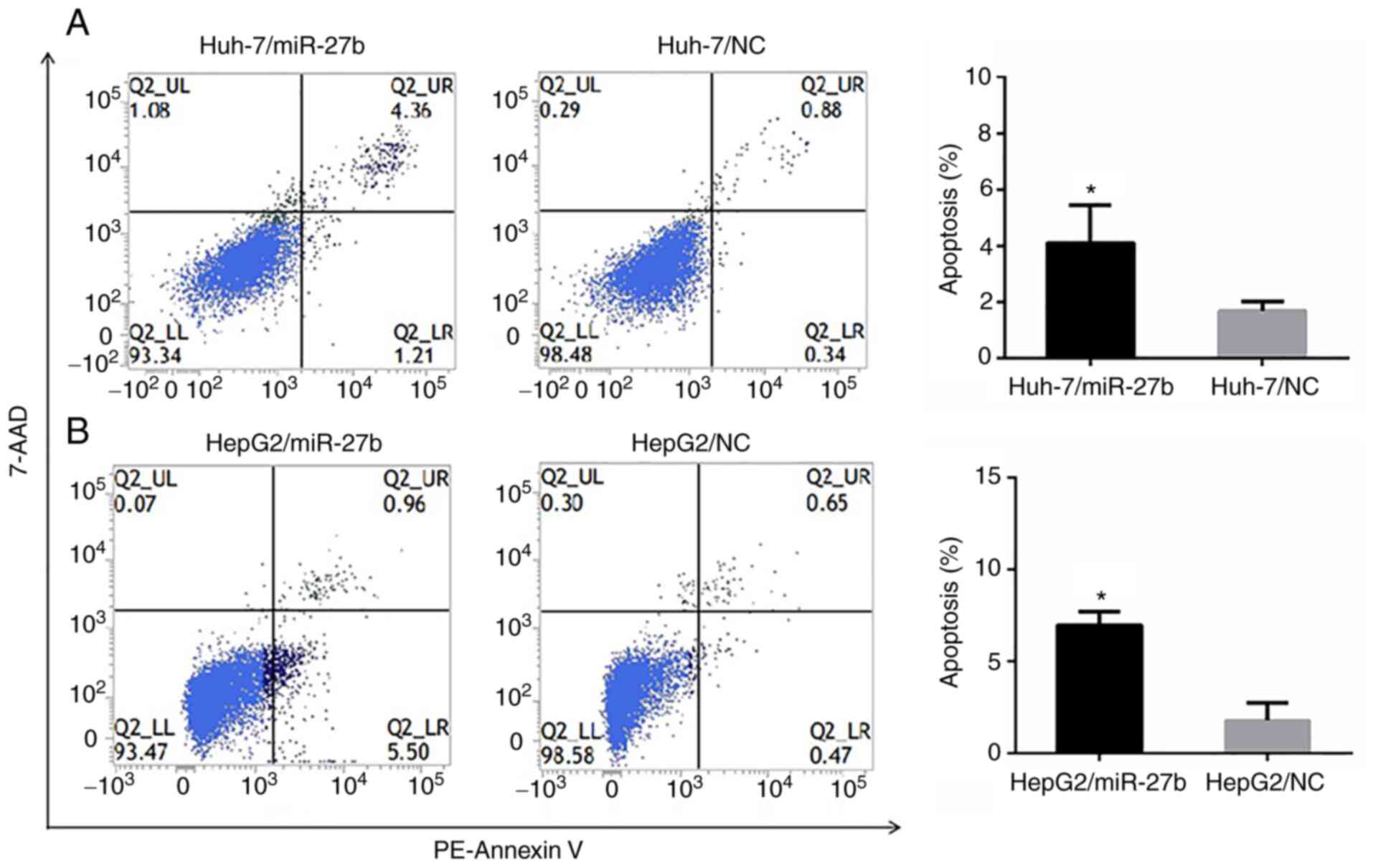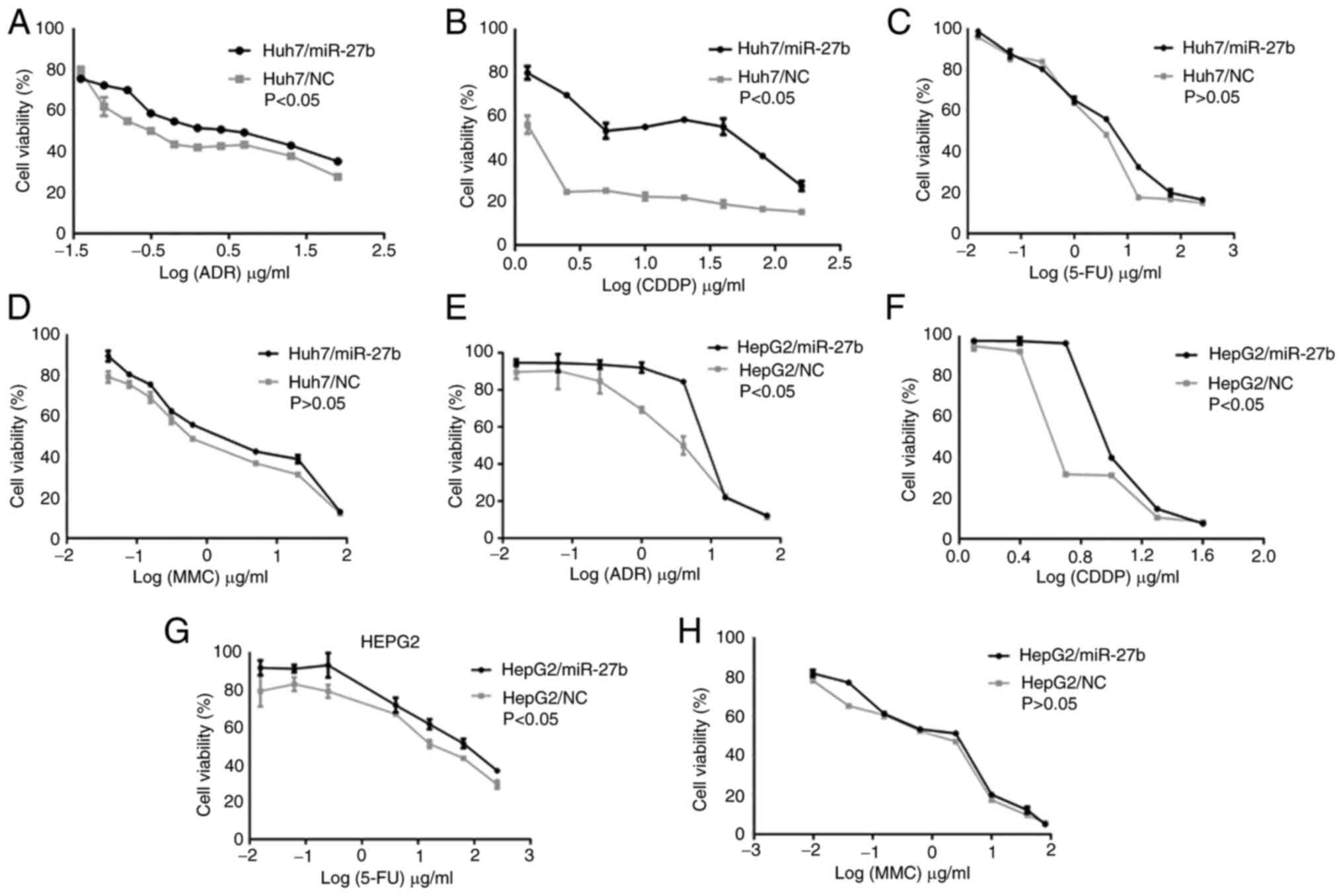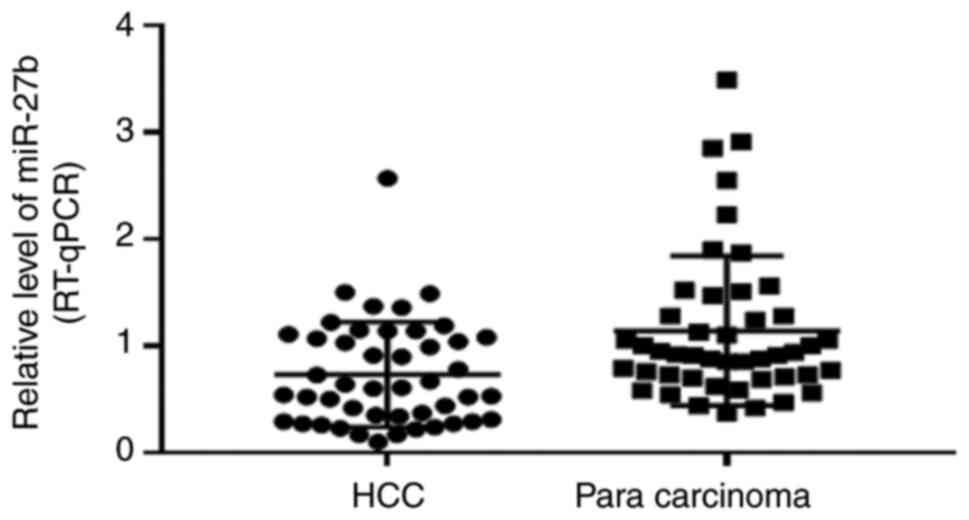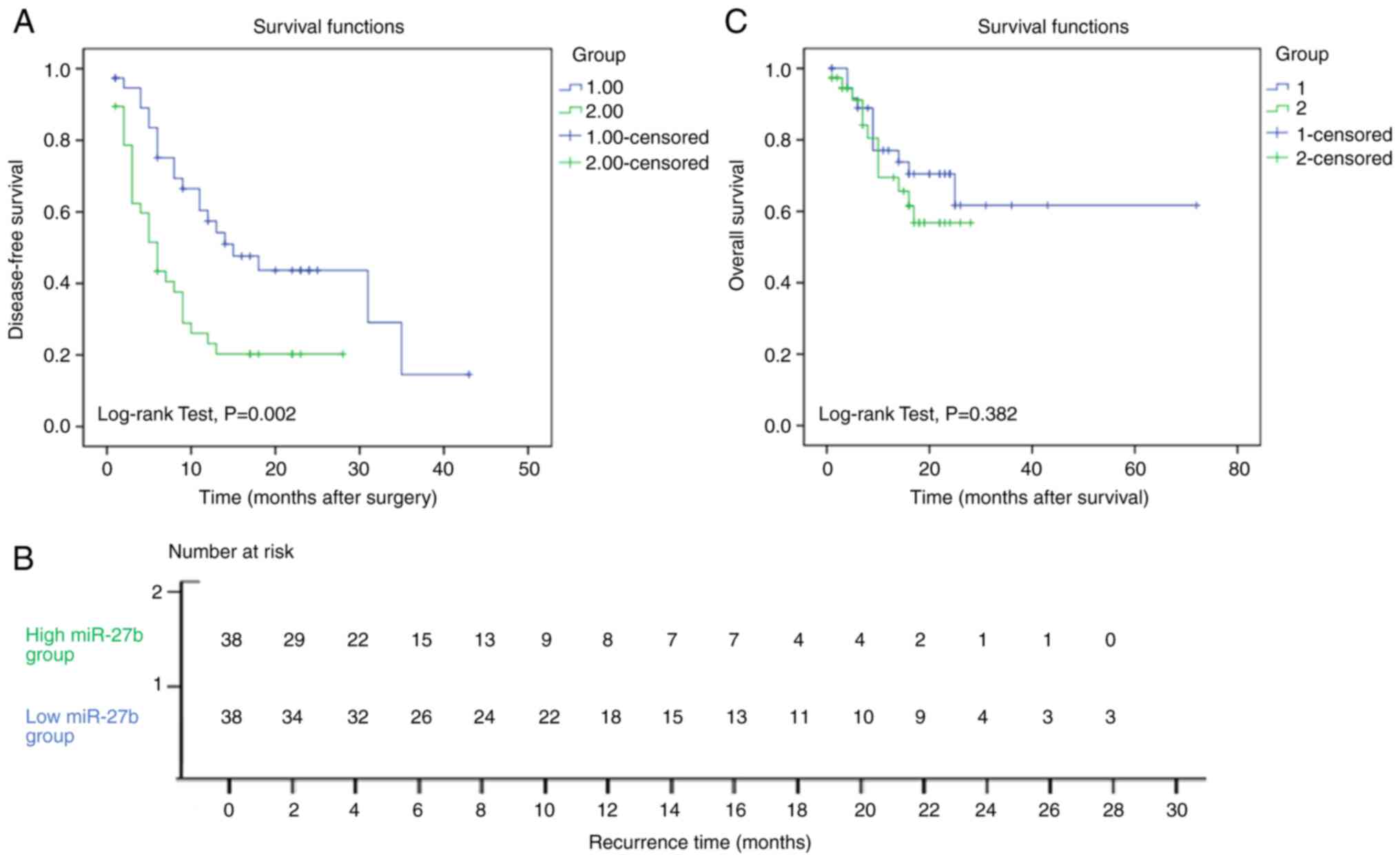Expression and effect of miR‑27b in primary liver cancer
- Authors:
- Published online on: December 20, 2023 https://doi.org/10.3892/ol.2023.14198
- Article Number: 65
-
Copyright: © Zhuo et al. This is an open access article distributed under the terms of Creative Commons Attribution License.
Abstract
Introduction
Liver cancer is predicted to be the sixth most commonly diagnosed cancer and the fourth leading cause of cancer-related death worldwide in 2018, with ~841,000 new cases and 782,000 deaths occurring annually (1). Hepatocarcinogenesis requires a number of genetic regulations and multistep aberrant biological processes, eventually leading to the malignant transformation of hepatocytes. Surgical resection is the main treatment for liver cancer. However, hepatocellular carcinoma (HCC), comprising 75–85% of primary liver cancer cases (1), has a high post-surgery recurrence rate (up to 70% in 5 years) (2) due to hematogenous metastasis, especially intrahepatic hematogenous metastasis occurring in the early stage of HCC. Moreover, surgical removal can be unachievable due to the size and distribution of the tumor in the liver, hypohepatia and extrahepatic metastasis. Some neoadjuvant therapies, such as transarterial chemoembolization (TACE), has been revealed to improve the overall disease-free survival period of patients with liver cancer after resection (3). However, drug resistance, including primary resistance and multidrug resistance, limits the chemotherapeutic effect in some patients with liver cancer. Additionally, most anticancer drugs have side effects that reduce the quality of life of patients with liver cancer, thus it is important to discover predictive factors to identify whether the patients will be sensitive to chemotherapy or not.
Altered expression of miRNAs plays an important role in the occurrence, development and drug resistance of human tumors (4). miRNAs are small non-coding RNA molecules of 20–23 nucleotides in length which regulate a variety of biologic processes such as apoptosis, proliferation, differentiation, development and metabolism. In a previous study conducted by the authors, miRNA expression profiles were detected and characterized in four types of liver cancer drug resistance cell sublines, finding that miRNA-27b (miR-27b) expression was upregulated in all four compared with the parental cell line Huh-7 (5).
miR-27b belongs to the miR-23b~27b~24-1 cluster, which is localized at chromosome q22.32 within the C9orf3 gene. A number of studies indicated that miR-27b is involved in the development and progression of tumors (6–9). According to previous findings of the authors, it was hypothesized that altered expression of miR-27b might be involved in mediating resistance to chemotherapy in HCC, a hypothesis which remains unclear in present literature (5). In addition, the role of miR-27b in the development and procession of liver cancer remains elusive. In the present study, the authors aimed to determine the influence of miR-27b in the occurrence, development and drug resistance of liver cancer cells.
Materials and methods
Patients and samples
A total of 76 human HCC tissue samples and 46 paired paracarcinoma tissue samples were obtained from adult patients diagnosed with HCC in the Division of Hepatobiliary Surgery within the Hepatic Disease Center of The First Affiliated Hospital of Fujian Medical University (Fuzhou, China) between 2007.1–2010.11. All patients with HCC underwent TACE after hepatectomy. Patients ranged in age from 28 to 78 years, with a median age of 51 years. There were 73 males and 3 females. All patients signed the informed consent and the present study was approved by the Ethics Committee of Fujian Medical University (approval no. FMU-2014-093; Fuzhou, China).
Cell lines and culture
Human liver cancer cell lines Huh-7 and HepG2 were obtained from The Cell Bank of Type Culture Collection of The Chinese Academy of Sciences. Cells were cultured in DMEM (high-glucose) (Gibco BRL Life Technologies Inc.) supplemented with 10% fetal bovine serum (Gibco BRL Life Technologies Inc.), 100 U/ml penicillin, 100 µg/ml streptomycin (Sigma-Aldrich LLC.) in a humidified incubator at 37°C with 5% CO2.
RNA isolation
Freshly resected tissue was immediately frozen in liquid nitrogen for subsequent total RNA extraction. Total RNA was extracted from cell lines and tissue samples using TRIzol® reagent (Invitrogen; Thermo Fisher Scientific, Inc.) according to manufacturer's instructions. The concentration of total RNA was quantitated by measuring the absorbance at 260 nm while RNA integrity was determined using 2% gel electrophoresis 0.5 µg/ml ethidium bromide.
Reverse transcription-quantitative PCR (RT-qPCR)
RNA samples were reverse transcribed into cDNA using a Universal cDNA synthesis kit (Takara Bio, Inc., Code No.:RR037A) according to the manufacturer's instructions. RT-qPCR amplification was performed on an Applied Biosystems 7500 Real-Time PCR System with the DNA-binding dye technique using SYBR Green (Takara Bio, Inc.) according to the manufacturer's instructions. U6 snRNA was used as a reference gene. The primers for miR-27b and U6 were purchased from Takara Bio, Inc. The primer sequence for the genes examined are presented in Table I. Thermocycling conditions were as follows: Initial denaturation temperature 95°C for 15 sec; annealing temperature 60°C for 30 sec. The relative expression of miR-27b was calculated according to the formula 2−ΔΔCq ΔΔCq=ΔCq of experimental sample-mean ΔCq of control samples) (10). Each RT-qPCR was performed in triplicates.
Construction of stable miR-27b overexpression liver cancer cell lines and control cell lines
Lentiviral transfer vector containing miR-27bprecursorsequenggugcagagcuuagcugauuggugaacagugauugguuuccgcuuuguucacaguggcuaaguucugcaccugaagagaaggug) (LPP-pEZX-MR03-eGFP-miR-27b) and lentiviral negative control vector (LPP-pEZX-MR03-eGFP-NC) were purchased from GeneCopoeia, Inc. The accuracy of the recombinant vector was verified by double digest and gene sequencing method. Lentiviral transfer vector (3.39×108TU/ml) and lentiviral negative control vector (3.05×108TU/ml) infected into cell lines with EndoFectin™ (GeneCopoeia Inc.) at 37°C for 15 h. At 72 h post-transfection, 1 µg/ml puromycin (Sigma-Aldrich LLC.) was added to screen for stable miR-27b overexpression and negative control cell lines. The screening period is about 10 to 15 days.
Cell proliferation assays
Cell Counting Kit-8 (CCK-8) assayExponentially growing cells were seeded into a 96-well plate at a density of 1×103 cells/well in 100 µl of culture medium. Cells were cultured in a CO2 incubator at 37°C for 24, 48, 72, 96 and 120 h. CCK-8 solution was added to wells at a concentration of 10 µl/well according to the manufacturer's instructions (Dojindo Laboratories, Inc.). The plate was incubated at 37°C for 2 h after which the absorbance [optical density (OD) value] at 450 nm was measured using a microplate reader (Model550; Omega Bio-Tek, Inc.). Independent experiments were performed in triplicates. A cell viability curve was created, plotting time is demonstrated in the X-axis coordinate and the number of cells (OD value) in the Y-axis coordinate.
Clone formation assay
A total of 6×102 exponentially growing cells were seeded onto a 60-mm petri dish. Cells were cultured in a CO2 incubator at 37°C for 2–3 weeks until cells in control plates have formed colonies that were of a substantially good size (>50 cells/colony). At room temperature, cells were fixed with −20°C precooled formaldehyde for 15 min and stained with 0.1% Giemsa solution (Beijing Leagene Biotech Co., Ltd.) for 20 min. The number of colonies was then counted and expressed as the mean ± standard deviation of triplicate wells within the same experiment.
Immunohistochemical staining (IHC) with cell pellets
Exponentially growing cells were harvested by trypsinization and washed with PBS. Cells were pelleted with 2% agarose after fixation with 10% formalin at room temperature for 2 h. Cell pellets were processed into paraffin blocks. After being dewaxed, hydrated, blocked with 3% H2O2 (Fuzhou Maixin Biotech Co., Ltd.) at 37°C for 15 min, paraffin sections (thickness:5 um) were incubated overnight at 4°C with mouse anti-human Ki-67 antibody (ready to use; cat. no. MAB-0672; Fuzhou Maixin Biotech Co., Ltd.). After three washes of 5 min with PBS, sections were incubated at room temperature with biotinylated goat anti-mouse IgG/HRP secondary antibody (ready to use; cat. no. KIT-9701; Fuzhou Maixin Biotech Co., Ltd.) for 1 h, followed by three additional washes of 5 min with PBS. DAB solution was used for visualization of the samples. As a negative control, the primary antibody was replaced with PBS. Sections were observed under a light microscope and images were captured with Olympus DP74 (Olympus Corporation). Image-Pro Plus 6.0 software (Media Cybernetics, Inc.) was used to analyze and calculate the average integrated OD (IOD) value.
Apoptosis assay using flow cytometry (FCM)
Exponentially growing cells were harvested by trypsinization and washed with PBS. Cells were resuspended with binding buffer at a density of 6×106 cells/ml and 100 µl of the cell suspension were transferred into a 1.5-ml Eppendorf tube. Annexin V-PE (1.5 µl) and 5 µl 7-AAD were added in a step wise manner. Finally, apoptosis was measured by flow cytometer (BD FACSVerse™; BD Biosciences) after 1 h. Software FACSuite (v1.0.5.3841; BD Biosciences) was used for data analysis. The experiment was repeated three times.
MTT cell viability assay (drug sensitivity assay)
Exponentially growing cells were seeded at 4×103 cells per well in 96-well plates with 100 µl of culture medium/well and incubated at 37°C for 14 h. The cells were then exposed to different concentrations of chemotherapy drugs such as 5-fluorouracil (5-FU; 15.625, 62.5, 250 ng/ml, 1, 4, 16 µg/m, 64, 256 µg/ml; Jinyao Pharmaceutical Co., LTD, Tianjin), adriamycin (ADR) (concentrations: 15.625, 62.5, 250 ng/ml, 1, 4, 16, 64, 256 µg/ml; Sigma-Aldrich LLC.), cisplatin (CDDP) (concentrations: 1.25, 2.5, 5, 10, 20, 40, 80, 160 µg/ml; Mackerlin Biochemical Technology Co., LTD, Shanghai) and mitomycin-C (MMC; 9.765625, 39.0625, 156.25, 625 ng/ml, 2.5, 10, 40, 80 µg/ml; Roche, Switzerland) at 37°C for 48 h. At the end of the drug exposure period, 20 µl of MTT (5 mg/ml in PBS) was added into each well and cells were cultured at 37°C for an additional 4 h (approximate time for the formation of formalin crystals). Subsequently, 150 µl DMSO were added to each well to dissolve the crystals. The optical density values were then measured at 570 nm using a microplate ELISA reader (Model550; Omega Bio-Tek, Inc.). Each experiment was performed in quintuplicates and repeated thrice. Resistance factors (RF) were calculated by dividing the IC50 value (drug concentration results in 50% reduction in absorbance compared with the control) of drug resistant cells with that of the parental control cells.
Statistical analysis
The ΔCq value (ΔCq=Cq value of miR-27b-Cq value of U6) of all samples was calculated for RT-qPCR assessments. The relative expression levels of miR-27b was calculated by the formula 2−ΔΔCq (ΔΔCq=ΔCq of experimental sample-mean ΔCq of control samples). The samples were divided into the high miR-27b expression group and the low miR-27b expression group according to their miR-27b levels. The significance of differences was determined with unpaired and paired Student's t-test, two-way ANOVA and Bonferroni's post-hoc test, Cox regression and Kaplan-Meier survival analysis (log-rank test) based on different data types. Values were expressed as the mean ± standard deviation. P<0.05 was considered to indicate a statistically significant difference. All statistical procedures were performed in SPSS version 16.0 (SPSS, Inc.) or in GraphPad Prism 7 (Dotmatics; GraphPad Software).
Results
Establishment of two stable miR-27b overexpression liver cancer cell lines and a control cell line
A total of two stable miR-27b overexpression liver cancer cell lines and a control cell line were established. These cells lines were named respectively as: Huh-7/miR-27b, Huh-7/NC, HepG2/miR-27b and HepG2/NC. The relative miR-27b level of Huh-7/miR-27b and HepG2/miR-27b was upregulated 2.05±0.59 fold and 2.13±0.53 fold, respectively, compared with the control cell line (all P-values were <0.01). Their cellular morphology and relative miR-27b expression levels are demonstrated in Fig. 1.
The effect of miR-27b expression on cell proliferation in liver cancer cells
CCK-8 assayA CCK-8 commercial cell counting kit was used to detect the cell proliferation of Huh-7/miR-27b, HepG2/miR-27b and their control cell lines. The OD values of Huh-7/miR-27b at 24, 48, 72, 96 and 120 h were 0.3±0.003, 0.331±0.065, 0.551±0.034, 0.742±0.037 and 1.207±0.113, respectively (Fig. 2A). The OD values of Huh-7/NC at 24, 48, 72, 96 and 120 h were 0.364±0.066, 0.48±0.055, 0.763±0.086, 1.060±0.017 and 1.573±0.043, respectively (Fig. 2A). The OD values of HepG2/miR-27b at 24, 48, 72, 96 and 120 h were 0.388±0.009, 0.611±0.011, 0.957±0.043, 1.004±0.059 and 1.388±0.099, respectively (Fig. 2B). The OD values of HepG2/NC at 24, 48, 72, 96 and 120 h were 0.403±0.064, 0.696±0.039, 1.144±0.053, 1.259±0.05 and 1.544±0.044, respectively (Fig. 2B). The OD values of Huh-7/miR-27b and HepG2/miR-27b at 24, 48, 72, 96 and 120 h were significantly lower than the control cell lines (all P<0.01).
Clone formation assay
A clone formation assay was used to detect the cell proliferation of Huh-7/miR-27b, HepG2/miR-27b and their control cell lines. The number of cell clones corresponding to Huh-7/miR-27b and Huh-7/NC were 104±9 and 200±22, respectively (Fig. 2C). The differences between them were statistically significant. The number of cell clones of HepG2/miR-27b and HepG2/NC were 111±40 and 180±53, respectively (Fig. 2D). The differences between them were statistically significant.
Immunohistochemical staining with Ki-67
Immunohistochemical staining with Ki-67 was employed to detect the cell proliferation of Huh-7/miR-27b, HepG2/miR-27b and their control cell lines. Expression of Ki-67 in Huh-7/miR-27b, Huh-7/NC, HepG2/miR-27b and HepG2/NC are exhibited in Fig. 2E-H. Ki-67 index values (the number of positive cells in 100 tumor cells) in Huh-7/miR-27b, Huh-7/NC, HepG2/miR-27b and HepG2/NC were 70, 82, 50 and 86%, respectively (data not shown). IOD of immunohistochemical staining with Ki-67 in Huh-7/miR-27b, Huh-7/NC, HepG2/miR-27b and HepG2/NC were 361.15±58.50, 589.02±143.39, 363.61±80.94 and 545.98±79.43, respectively (data not shown). IOD of immunohistochemical staining with Ki-67 in Huh-7/miR-27b and HepG2/miR-27b were statistically lower than the negative control cell line (unpaired Student's t-test, P<0.05).
The effect of miR-27b on cell apoptosis in liver cancer cells
The FCM analysis evaluating apoptosis revealed that the apoptotic rates (%) of Huh-7/miR-27b, Huh-7/NC, HepG2/miR-27b and HepG2/NC were 4.11±1.35, 1.70±0.33, 6.98±0.73 and 1.79±0.95, respectively. The apoptotic rates of Huh-7/miR-27b and HepG2/miR-27b cell lines were significantly higher than the negative control cell line (Fig. 3A and B).
The effect of miR-27b on drug sensitivity in liver cancer cells
The IC50 values and RF of cell lines, presented in Table II, indicated that compared with Huh-7/NC, Huh-7/miR-27b was less sensitive to ADR and CDDP (Fig. 4A and B). There was not a significant difference between Huh-7/miR-27b and Huh-7/NC (Fig. 4C and D) in their sensitivity to either 5-FU or MMC. Compared with HepG2/NC, HepG2/miR-27b was less sensitive to ADR, CDDP and 5-FU (Fig. 4E-G). There was no significant difference in sensitivity to MMC between HepG2/miR-27b and HepG2/NC (Fig. 4H).
Table II.The IC50 values and RF to four drugs of miR-27b overexpression liver cell lines and their control cell lines. |
miR-27b expression in HCC and paracarcinoma tissue
Association between miR-27b level in HCC and paired paracarcinoma tissuesThe expression of miR-27 in HCC tissues was found to be lower than paired paracarcinoma tissues. Specifically, the relative level of miR-27b in HCC tissues and paired paracarcinoma tissues was 0.73±0.49 and 1.14±0.7, respectively. The miR-27b level in HCC tissues was significantly lower than in liver tissues adjacent to the tumor (P<0.01). The relative miR-27b expression levels in tissues are demonstrated in Fig. 5.
The relationship of miR-27b expression and clinicopathological parameters in patients with HCC
The association between miR-27b expression and the clinicopathological parameters of patients with HCC is presented in Table III. The miR-27b level in samples from HCC patients with cirrhosis was remarkably lower compared with patients without cirrhosis. Notably, HCC tissues from patients <40 years old had higher miR-27b expression levels than patients >40 years old. Furthermore, the level of miR-27b in patients with abnormal liver function [alanine aminotransferase (ALT) ≥40 U/l] was lower than in the normal group (ALT <40 U/l). Conversely, the level of miR-27b in the high serum α-fetoprotein (AFP) expression group was higher than that in the low AFP expression group. However, there were no statistically significant differences in miR-27b level and nodule number, tumor size, vascular invasion, degree of differentiation, TNM stage, extrahepatic metastasis, serum HBsAg, total bilirubin, Y-glutamyltranspeptidase, or albumin.
The relationship of miR-27b expression and disease prognosis
Bounded by the median miR-27b level, HCC samples were divided into high miR-27b expression group (38 cases) and low miR-27b expression group (38 cases). The recurrence time (disease-free survival time) of the low miR-27b expression group (20.8±2.7 months) was longer than that of the high miR-27b expression group, the recurrence time of which was 9.7±1.6 months. This doubling of disease-free survival time was statistically significant (P=0.002). The Kaplan-Meier survival curve is demonstrated in Fig. 6A. The number of subjects at risk is shown in Fig. 6B. To identify variables with potential prognostic significance, univariate and multivariate analyses for each variable in relation to the disease-free survival time of patients with HCC were conducted. Clinicopathologic factors with a significant impact on the recurrence time in univariate Cox regression analysis included miR-27b (P=0.004), vascular invasion (P=0.006), extrahepatic metastasis (P<0.001), number of tumors (P=0.014), TNM stages (P<0.001), tumor size (P=0.024) and serum ALT (P=0.009). In multivariate analyses, miR-27b expression (P=0.012), extrahepatic metastasis (P<0.001), number of tumors (P=0.003), differentiated status (P=0.033), serum AFP (P=0.034) and serum ALT (P=0.004) were significant independent factors for tumor recurrence (Table IV).
Table IV.Univariate and multivariate Cox regression analyses of recurrence-free survival in HCC patients underwent TACE after hepatectomy. |
However, there was no statistically significant difference between the overall survival time of the low miR-27b expression group and the high miR-27b expression group. The Kaplan-Meier survival curve is illustrated in Fig. 6C.
Discussion
In the present study, miR-27b expression in patients with HCC who underwent TACE after hepatectomy was assessed. It was found that miR-27b expression in HCC tissues was lower than in paired paracarcinoma liver tissues. Upon analyzing the relationship between miR-27b expression and various clinicopathological parameters, the authors observed that miR-27b levels were associated with age, cirrhosis, serum AFP and ALT levels before the operation. In addition, the results revealed that the disease-free survival time of the low miR-27b expression group was twice as long as that in the high miR-27b expression group. At the same time, in vitro cell experiments demonstrated that upregulation of miR-27b inhibited cell proliferation, promoted cell apoptosis and reduced chemosensitivity in liver cancer cell lines.
Recent studies have demonstrated aberrant miR-27b expression levels in various cancers, indicating its potential role in cancer progression. For instance, Li et al (7) indicated that miR-27b was significantly downregulated in tongue squamous cell carcinoma (TSCC) tissues and overexpression of miR-27b led to diminished proliferation, migration and invasion.
Numerous researchers have demonstrated that miR-27b can play a suppressive role in several cancers including TSCC (7), breast cancer (11), gastric cancer (12,13), lung cancer (14), esophageal squamous cell carcinoma (8) and colorectal cancer (15). As for liver cancer, Liang et al (16) reported that the expression of miR-27b in tumor tissues is lower than that in adjacent non-tumor tissues. This finding opposed the results of Sun et al (17) and He et al (18), who suggested that miR-27b serves as an oncogenic miRNA in HCC by modulating proliferation, cell cycle progression and apoptosis. In the present study, miR-27b level was found to be lower in tumor tissues. Meanwhile, the findings of the present study indicated that upregulation of miR-27b in liver cancer cells suppressed cell proliferation and promoted cell apoptosis. This suggested that miR-27b acts as a liver cancer suppressor. The results of the present study also indicated that the expression level of miR-27b in the low age group was higher than that in the high age group, which is consistent with the fact that HCC tends to occur in middle-aged and elderly people.
In addition, miR-27b may play an important role in chemosensitivity of cancers, though its effect on chemotherapeutic resistance of tumors is also controversial. Zhang et al (9) revealed that miR-27b and miR-34a overexpression enhanced docetaxel sensitivity of prostate carcinoma partly through inhibiting epithelial-to-mesenchymal transition (EMT) by targeting zinc finger E-Box binding homeobox 1. On the contrary, Xu et al (19) observed that downregulation of miR-27b can increase the chemosensitivity of the doxorubicin (Dox) resistant cell lines of human anaplastic thyroid cancer, specifically, SW1736/Dox and 8305C/Dox cells. In the present study, upregulation of miR-27b significantly reduced the sensitivity to chemotherapeutic drugs (ADR, CDDP and 5-FU) in liver cancer Huh-7 and HepG2 cells. Moreover, after analyzing the association of miR-27b levels with clinicopathological parameters in patients with HCC, it was demonstrated that the period of disease recurrence of the low miR-27b expression group was longer than that of the high miR-27b expression group. As all patients with HCC in the present study underwent TACE after hepatectomy, it can be assumed that patients with HCC who had low miR-27b expression levels experienced improved chemotherapeutic effects due to higher sensitivity to the drugs. Collectively, these results indicated that miR-27b may act as a biomarker to estimate the curative effect of chemotherapeutics and as a determinant of the appropriate treatment course for patients with HCC.
miR-27b acts as both a tumor suppressor and a biomarker of chemoresistance, although the underlying mechanism has not been fully investigated. Li et al (7) detected that miR-27b inhibited TSCC proliferation and migration via suppressing the EMT process by targeting integrin subunit alpha 5. The study of Han et al (8) indicated that miR-27b-3p suppresses cell proliferation, migration, invasion and EMT via suppressing nuclear factor erythroid 2-related factor 2. In addition, Bai et al (20) reported that miR-27b-3p overexpression can inhibit EMT and alleviate renal fibrosis via suppressing STAT1 both in vivo and in vitro. The etiology and pathogenesis of HCC are not clear, but numerous studies have demonstrated that cirrhosis is a high-risk factor for HCC (21). The results of the present study revealed that patients with cirrhosis have lower miR-27b levels compared with the patients without cirrhosis. This suggested that reduced miR-27b expression may induce EMT and lead to cirrhosis and then promote the occurrence of liver cancer. The mechanism of miR-27b in inhibiting proliferation, promoting apoptosis and conferring chemotherapeutic resistance in HCC is slowly coming to light. However, more has to be discovered through follow-up research. Pending aims include the screening of miR-27b target genes by using bioinformatics analysis software and detection of liver cancer tissues, miR-27b overexpression HCC cell lines and a control cell line. Subsequently, the target genes would be verified by double luciferase reporting assays and functional experiments.
Acknowledgements
The authors would like to thank Mr. Junjin Lin (Public Technology Service Center, Fujian Medical University) for technical assistance with the flow cytometry.
Funding
The present study was supported from the Natural Science Foundation of Fujian (grant nos. 2015J01310 and 2019J01298).
Availability of data and materials
The datasets generated during and/or analyzed during the current study are available from the corresponding author on reasonable request.
Authors' contributions
AMH, LJZ and WMZ designed the study. LJZ and LLZ conducted most of the experiments and HC conducted part of the experiments. LJZ and LLZ analyzed the data. LJZ and AMH wrote the manuscript. All authors have read and approved the final version of the manuscript. LJZ and LLZ confirm the authenticity of all the raw data.
Ethics approval and consent to participate
Ethical approval for this study was obtained from the Ethics Committee of Fujian Medical University (approval no. FMU-2014-093; Fuzhou, China). Written informed consent was obtained from all participants included in the study.
Patient consent for publication
Not applicable.
Competing interests
The authors declare that they have no competing interests.
References
|
Bray F, Ferlay J, Soerjomataram I, Siegel RL, Torre LA and Jemal A: Global cancer statistics 2018: GLOBOCAN estimates of incidence and mortality worldwide for 36 cancers in 185 countries. CA Cancer J Clin. 68:394–424. 2018. View Article : Google Scholar : PubMed/NCBI | |
|
Saraiya N, Yopp AC, Rich NE, Odewole M, Parikh ND and Singal AG: Systematic review with meta-analysis: Recurrence of hepatocellular carcinoma following direct-acting antiviral therapy. Aliment Pharmacol Ther. 48:127–137. 2018. View Article : Google Scholar : PubMed/NCBI | |
|
Lohitesh K, Chowdhury R and Mukherjee S: Resistance a major hindrance to chemotherapy in hepatocellular carcinoma: An insight. Cancer Cell Int. 18:442018. View Article : Google Scholar : PubMed/NCBI | |
|
Ventura A and Jacks T: MicroRNAs and cancer: Short RNAs go a long way. Cell. 136:586–591. 2009. View Article : Google Scholar : PubMed/NCBI | |
|
Zhuo L, Liu J, Wang B, Gao M and Huang A: Differential miRNA expression profiles in hepatocellular carcinoma cells and drug-resistant sublines. Oncol Rep. 29:555–562. 2013. View Article : Google Scholar : PubMed/NCBI | |
|
Bao CH and Guo L: Retracted: miR-27b-3p inhibits invasion, migration and epithelial-mesenchymal transition in gastric cancer by targeting RUNX1 and activation of the hippo signaling pathway. Anticancer Agents Med Chem. 22:864–873. 2022. View Article : Google Scholar : PubMed/NCBI | |
|
Li T, Wu Q, Liu D and Wang X: miR-27b suppresses tongue squamous cell carcinoma epithelial-mesenchymal transition by targeting ITGA5. Onco Targets Ther. 13:11855–11867. 2020. View Article : Google Scholar : PubMed/NCBI | |
|
Han M, Li N, Li F, Wang H and Ma L: MiR-27b-3p exerts tumor suppressor effects in esophageal squamous cell carcinoma by targeting Nrf2. Hum Cell. 33:641–651. 2020. View Article : Google Scholar : PubMed/NCBI | |
|
Zhang G, Tian X, Li Y, Wang Z, Li X and Zhu C: miR-27b and miR-34a enhance docetaxel sensitivity of prostate cancer cells through inhibiting epithelial-to-mesenchymal transition by targeting ZEB1. Biomed Pharmacother. 97:736–744. 2018. View Article : Google Scholar : PubMed/NCBI | |
|
Livak KJ and Schmittgen TD: Analysis of relative gene expression data using real-time quantitative PCR and the 2(−Delta Delta C (T)) method. Methods. 25:402–408. 2001. View Article : Google Scholar : PubMed/NCBI | |
|
Chen D, Si W, Shen J, Du C, Lou W, Bao C, Zheng H, Pan J, Zhong G, Xu L, et al: miR-27b-3p inhibits proliferation and potentially reverses multi-chemoresistance by targeting CBLB/GRB2 in breast cancer cells. Cell Death Dis. 9:1882018. View Article : Google Scholar : PubMed/NCBI | |
|
Chen X, Cui Y, Xie X, Xing Y, Yuan Z and Wei Y: Functional role of miR-27b in the development of gastric cancer. Mol Med Rep. 17:5081–5087. 2018.PubMed/NCBI | |
|
Feng Q, Wu X, Li F, Ning B, Lu X, Zhang Y, Pan Y and Guan W: miR-27b inhibits gastric cancer metastasis by targeting NR2F2. Protein Cell. 8:114–122. 2017. View Article : Google Scholar : PubMed/NCBI | |
|
Sun Y, Xu T, Cao YW and Ding XQ: Antitumor effect of miR-27b-3p on lung cancer cells via targeting Fzd7. Eur Rev Med Pharmacol Sci. 21:4113–4123. 2017.PubMed/NCBI | |
|
Luo Y, Yu SY, Chen JJ, Qin J, Qiu YE, Zhong M and Chen M: MiR-27b directly targets Rab3D to inhibit the malignant phenotype in colorectal cancer. Oncotarget. 9:3830–3841. 2017. View Article : Google Scholar : PubMed/NCBI | |
|
Liang H, Ai-Jun J, Ji-Zong Z, Jian-Bo H, Liang Z, Yong-Xiang Y and Chen Y: Clinicopathological significance of miR-27b targeting Golgi protein 73 in patients with hepatocellular carcinoma. Anticancer Drugs. 30:186–194. 2019. View Article : Google Scholar : PubMed/NCBI | |
|
Sun XF, Sun JP, Hou HT, Li K, Liu X and Ge QX: MicroRNA-27b exerts an oncogenic function by targeting Fbxw7 in human hepatocellular carcinoma. Tumour Biol. 37:15325–15332. 2016. View Article : Google Scholar : PubMed/NCBI | |
|
He S, Zhang J, Lin J, Zhang C and Sun S: Expression and function of microRNA-27b in hepatocellular carcinoma. Mol Med Rep. 13:2801–2808. 2016. View Article : Google Scholar : PubMed/NCBI | |
|
Xu Y, Han YF, Ye B, Zhang YL, Dong JD, Zhu SJ and Chen J: miR-27b-3p is involved in doxorubicin resistance of human anaplastic thyroid cancer cells via targeting peroxisome proliferator-activated receptor gamma. Basic Clin Pharmacol Toxicol. 123:670–677. 2018. View Article : Google Scholar : PubMed/NCBI | |
|
Bai L, Lin Y, Xie J, Zhang Y, Wang H and Zheng D: MiR-27b-3p inhibits the progression of renal fibrosis via suppressing STAT1. Hum Cell. 34:383–393. 2021. View Article : Google Scholar : PubMed/NCBI | |
|
Sharma SA, Kowgier M, Hansen BE, Brouwer WP, Maan R, Wong D, Shah H, Khalili K, Yim C, Heathcote EJ, et al: Toronto HCC risk index: A validated scoring system to predict 10-year risk of HCC in patients with cirrhosis. J Hepatol. S0168-8278(17)32248-1. 2017.(Epub ahead of print). |



